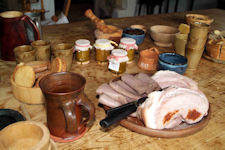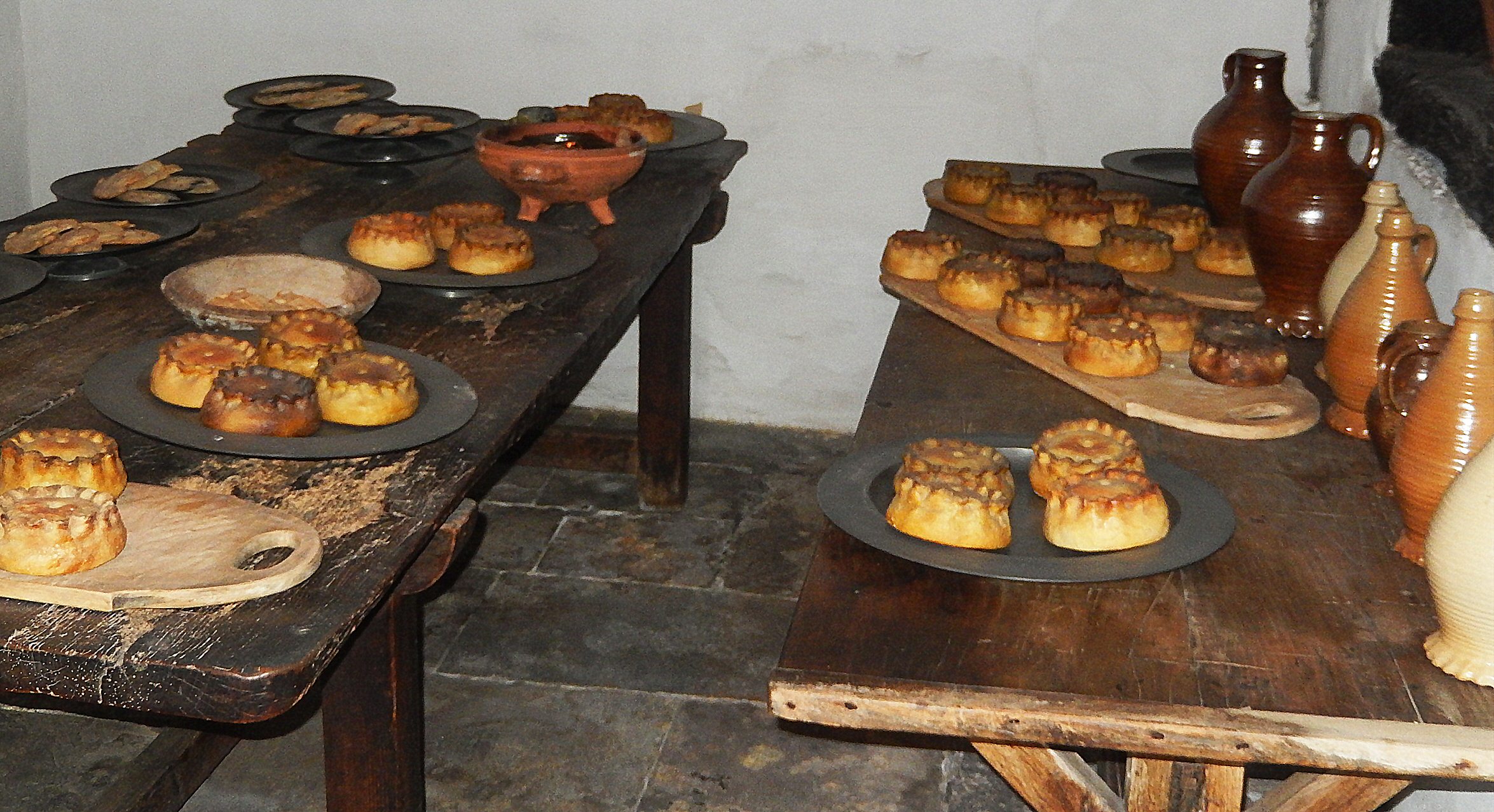Tudor Food And Drink on:
[Wikipedia]
[Google]
[Amazon]
Tudor food is the food consumed during the

 * brawn (boar meat)
* roast tongue
* leg of pork
* roast beef
* deer
* meat
* vegetables in season
* bread
* wine
* brawn (boar meat)
* roast tongue
* leg of pork
* roast beef
* deer
* meat
* vegetables in season
* bread
* wine
Tudor period
The Tudor period occurred between 1485 and 1603 in History of England, England and Wales and includes the Elizabethan period during the reign of Elizabeth I until 1603. The Tudor period coincides with the dynasty of the House of Tudor in Englan ...
of English history, from 1485 through 1603. A common source of food during the Tudor period was bread, which was sourced from a mixture of rye and wheat. Meat was also eaten, with the poor and rich eating different types of meat. New foods were being brought from the newly discovered Americas
The Americas, which are sometimes collectively called America, are a landmass comprising the totality of North and South America. The Americas make up most of the land in Earth's Western Hemisphere and comprise the New World.
Along with th ...
, such as tomatoes and potatoes. The rich commonly held banquets
A banquet (; ) is a formal large meal where a number of people consume food together. Banquets are traditionally held to enhance the prestige of a host, or reinforce social bonds among joint contributors. Modern examples of these purposes i ...
, that consisted of a large variety of meat sources. Ale and wine were the common drinks of the time.
Food
Vegetables The common vegetables used in the Tudor period were onions and cabbages, but nearer the end of the Tudor period, new foods were brought over from the Americas, such as tomatoes, potatoes and carrots. Meat The poor ate whatever meat they could find, such as rabbits, blackbirds,pheasant
Pheasants ( ) are birds of several genera within the family (biology), family Phasianidae in the order (biology), order Galliformes. Although they can be found all over the world in introduced (and captive) populations, the pheasant genera na ...
s, partridge
A partridge is a medium-sized Galliformes, galliform bird in any of several genera, with a wide Indigenous (ecology), native distribution throughout parts of Europe, Asia and Africa. Several species have been introduced to the Americas. They a ...
s, hens, duck
Duck is the common name for numerous species of waterfowl in the family Anatidae. Ducks are generally smaller and shorter-necked than swans and geese, which are members of the same family. Divided among several subfamilies, they are a form t ...
s, and pigeons, and also fish they caught from lakes and rivers. Meanwhile, the rich people also ate more costly varieties of meat, such as swan
Swans are birds of the family (biology), family Anatidae within the genus ''Cygnus''. The swans' closest relatives include the goose, geese and ducks. Swans are grouped with the closely related geese in the subfamily Anserinae where they form t ...
, peafowl
Peafowl is a common name for three bird species in the genera '' Pavo'' and ''Afropavo'' within the tribe Pavonini of the family Phasianidae, the pheasants and their allies. Male peafowl are referred to as peacocks, and female peafowl are refe ...
, geese
A goose (plural, : geese) is a bird of any of several waterfowl species in the family (biology), family Anatidae. This group comprises the genera ''Anser (bird), Anser'' (the grey geese and white geese) and ''Branta'' (the black geese). Some o ...
, boar
The wild boar (''Sus scrofa''), also known as the wild swine, common wild pig, Eurasian wild pig, or simply wild pig, is a suid native to much of Eurasia and North Africa, and has been introduced to the Americas and Oceania. The species is no ...
, and deer
Deer or true deer are hoofed ruminant mammals forming the family Cervidae. The two main groups of deer are the Cervinae, including the muntjac, the elk (wapiti), the red deer, and the fallow deer; and the Capreolinae, including the reindeer ...
(venison
Venison originally meant the meat of a game animal but now refers primarily to the meat of antlered ungulates such as elk or deer (or antelope in South Africa). Venison can be used to refer to any part of the animal, so long as it is edible, in ...
).
Herbs
Herbs were often used by rich Tudors to flavour their meals. They created separate herb gardens to grow what they needed, such as parsley
Parsley, or garden parsley (''Petroselinum crispum'') is a species of flowering plant in the family Apiaceae that is native to the central and eastern Mediterranean region (Sardinia, Lebanon, Israel, Cyprus, Turkey, southern Italy, Greece, Por ...
, mint, rosemary
''Salvia rosmarinus'' (), commonly known as rosemary, is a shrub with fragrant, evergreen, needle-like leaves and white, pink, purple, or blue flowers, native plant, native to the Mediterranean Region, Mediterranean region. Until 2017, it was kn ...
, thyme
Thyme () is the herb (dried aerial parts) of some members of the genus ''Thymus'' of aromatic perennial evergreen herbs in the mint family Lamiaceae. Thymes are relatives of the oregano genus ''Origanum'', with both plants being mostly indigenou ...
and sage.
Bread
Tudors of all classes consumed bread
Bread is a staple food prepared from a dough of flour (usually wheat) and water, usually by baking. Throughout recorded history and around the world, it has been an important part of many cultures' diet. It is one of the oldest human-made f ...
in all of their meals as the main source of carbohydrate
In organic chemistry, a carbohydrate () is a biomolecule consisting of carbon (C), hydrogen (H) and oxygen (O) atoms, usually with a hydrogen–oxygen atom ratio of 2:1 (as in water) and thus with the empirical formula (where ''m'' may or ma ...
s; however, its quality varied. The cheapest bread available was Carter's bread, which was a mixture of rye and wheat
Wheat is a grass widely cultivated for its seed, a cereal grain that is a worldwide staple food. The many species of wheat together make up the genus ''Triticum'' ; the most widely grown is common wheat (''T. aestivum''). The archaeologi ...
. The middle class or prosperous tenants ate ravel—also known as yeoman's bread—made of wholemeal
A whole grain is a grain of any cereal and pseudocereal that contains the endosperm, germ, and bran, in contrast to refined grains, which retain only the endosperm.
As part of a general healthy diet, consumption of whole grains is associated wit ...
. The most expensive bread was manchet, made of white wheat flour.
Banquets and feasts
Thearistocrats
Aristocracy (, ) is a form of government that places strength in the hands of a small, privileged ruling class, the aristocrats. The term derives from the el, αριστοκρατία (), meaning 'rule of the best'.
At the time of the word' ...
held banquets and feasts consisting of different courses where each course had a variety of dishes brought out at the same time. People then could choose what they wanted to eat.
Starter
Dinner
* roast lamb * rabbit * bread * preserved fruit * gingerbread * sugared almonds * deer * fishBeverages
Everyone drankale
Ale is a Type of beer, type of beer brewed using a Warm fermentation, warm fermentation method, resulting in a sweet, full-bodied and fruity taste. Historically, the term referred to a drink brewed without hops.
As with most beers, ale typicall ...
during the Tudor period, as water was considered unhealthy. Ale at the time was brewed without hops, and was not particularly alcoholic. The rich also drank wine
Wine is an alcoholic drink typically made from fermented grapes. Yeast consumes the sugar in the grapes and converts it to ethanol and carbon dioxide, releasing heat in the process. Different varieties of grapes and strains of yeasts are m ...
, which was mostly imported from Europe
Europe is a large peninsula conventionally considered a continent in its own right because of its great physical size and the weight of its history and traditions. Europe is also considered a Continent#Subcontinents, subcontinent of Eurasia ...
, though some wine was produced by vineyards in Southern England
Southern England, or the South of England, also known as the South, is an area of England consisting of its southernmost part, with cultural, economic and political differences from the Midlands and the North. Officially, the area includes G ...
. In the early 16th century, wine was expensive for most commoners, therefore an Act from 1536 decreed that wine imported from France would have a price ceiling, with those imported from Greece and especially Spain with an even higher maximum selling price.
The rich drank from wine glass
A wine glass is a type of glass that is used to drink and taste wine. Most wine glasses are stemware (goblets), i.e., they are composed of three parts: the bowl, stem, and foot.
Shapes
The effect of glass shape on the taste of wine has not been ...
es imported from Italy
Italy ( it, Italia ), officially the Italian Republic, ) or the Republic of Italy, is a country in Southern Europe. It is located in the middle of the Mediterranean Sea, and its territory largely coincides with the homonymous geographical re ...
, which were incredibly expensive, while the poor drank from wooden goblets and cups.
Table manners
Having clean hands was very important, as several people would dig into a common dish with their fingers. Therefore, they were advised by "Miss Manners" of the day to wash their hands out in the open where everyone could see, to make sure that they were clean. Besides that, manuals for manners from theRenaissance
The Renaissance ( , ) , from , with the same meanings. is a period in European history marking the transition from the Middle Ages to modernity and covering the 15th and 16th centuries, characterized by an effort to revive and surpass ideas ...
and Middle Ages
In the history of Europe, the Middle Ages or medieval period lasted approximately from the late 5th to the late 15th centuries, similar to the post-classical period of global history. It began with the fall of the Western Roman Empire a ...
listed some things that were frowned upon at the dinner table, including:
* Putting fingers in the ears.
* Putting hands on the heads.
* Blowing nose with the hands.
* Men were told to refrain from scratching.
* Blowing noses off or wiping off sweat with napkins.
* Poking around on a plate, probably looking for the better piece of food.
* Throwing bones on the floor. The proper place for bones was a platter.
* The release of wind.
References
Further reading
{{commonscat, The Tudor Kitchens at Hampton Court Palace * Alison Sim (1997) ''Food and Feast in Tudor England''. Stroud: Sutton * Peter Brears (2003) ''Tudor Cookery: recipes & history''; revised. Swindon: English HeritageFood
Food is any substance consumed by an organism for nutritional support. Food is usually of plant, animal, or fungal origin, and contains essential nutrients, such as carbohydrates, fats, proteins, vitamins, or minerals. The substance is inge ...
History of food and drink